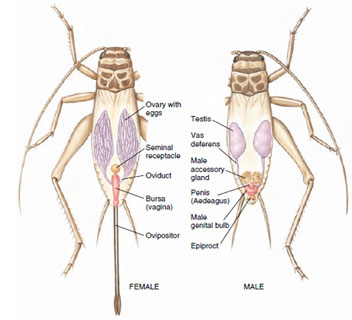Invertebrate Reproductive Systems
 |
| Figure 7-11 Reproductive system of crickets. Sperm from the paired testes of males pass through sperm tubes (vas deferens) to an ejaculatory duct housed in the penis. In females, eggs from the ovaries pass through oviducts to the genital bursa. At mating sperm enclosed in a membranous sac (spermatophore) formed by the secretions of the accessory gland are deposited in the genital bursa of the female, then migrate to her seminal receptacle where they are stored. The female controls the release of a few sperm to fertilize her eggs at the moment they are laid, using the needlelike ovipositor to deposit the eggs in the soil. |
Invertebrates that transfer sperm from male to female for internal fertilization require organs and plumbing to facilitate this function that may be as complex as those of any vertebrate. In contrast, reproductive systems of invertebrates that simply release their gametes into the water for external fertilization may be little more than centers for gametogenesis. Polychaete annelids, for example, have no permanent reproductive organs. Gametes arise by proliferation of cells lining the body cavity. When mature the gametes are released through coelomic or nephridial ducts or, in some species, may spill out through ruptures in the body wall.
Insects have separate sexes (dioecious), practice internal fertilization by copulation and insemination, and consequently have complex reproductive systems (Figure 7-11). Sperm from the testes pass through sperm ducts to seminal vesicles (where the sperm are stored) and then through a single ejaculatory duct to a penis. Seminal fluid from one or more accessory glands is added to the semen in the ejaculatory duct. Females have a pair of ovaries formed from a series of egg tubes (ovarioles). Mature ova pass through oviducts to a common genital chamber and then to a short copulatory bursa (vagina). In most insects, the male transfers sperm by inserting the penis directly into the female system where sperm are stored in a seminal receptacle. Often a single mating provides sufficient sperm to last the reproductive life of a female.




